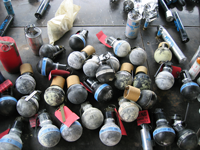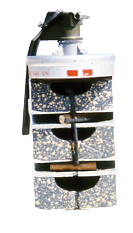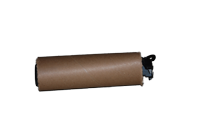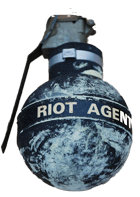Chemical Agent Instructor
| Home | • | Contact | • | Tear Gas Resource |
Storage of Chemical Agents

Any law enforcement agency that purchases non-lethal chemical agents will be required to store their agents pending use. There are three factors that law enforcement agencies consider when storing Non-lethal Chemical Agents.
The first factor is liability. What exposure we have personally and as an agency if we injure or kill a person with a Non-lethal Chemical Agents device that fails to function properly. If a law enforcement agency stores Non-lethal Chemical Agents contrary to OSHA guidelines they face civil fines.
OSHA storage regulations state, "(Non-lethal Chemical Agents) should be stored in a cool, dry, well-ventilated area in tightly sealed containers that are labeled in accordance with OSHA's Hazard Communication Standard [29 CFR 1910.1200]. Containers of (Non-lethal Chemical Agents) should be protected from physical damage and moisture, and should be stored separately from strong oxidizers.
Conveying equipment and storage containers should be electrically grounded during transfer to prevent the possibility of a dust explosion. All electrical service should be non-sparking and have an explosion-proof design. Any bulk storage system should have an explosion-relief design. Empty containers contain residues of (Non-lethal Chemical Agents) and should be handled accordingly.
Section 1910.1200 (b)(2) applies to any chemical which is known to be present in the workplace in such a manner that employees may be exposed under normal conditions of use or in a foreseeable emergency.
The phrase "known to be present" is essential to the scope of the standard. If a hazardous chemical is known to be present by the chemical manufacturer or the employer, it is covered by the standard. This includes chemicals to which employees may be exposed during normal operations or in a foreseeable emergency. This means that even though an employer was not responsible for the manufacture of the hazardous chemical, the employer has the responsibility for conveying hazards to his/her employees."
The second issue is reliability. It is critical that Non-lethal Chemical Agents devices function as designed. The law enforcement officer relies on the manufacturer's representations, his training and experience to deploy devices safely and effectively. If they are not stored properly the devices may fail to function as designed and the outcome of the deployment unpredictable. Some of the areas of a device that can be affected by improper storage include the Non-lethal Chemical Agents, primers, delay elements, propelling charges, detonators and bursting charges.
devices function as designed. The law enforcement officer relies on the manufacturer's representations, his training and experience to deploy devices safely and effectively. If they are not stored properly the devices may fail to function as designed and the outcome of the deployment unpredictable. Some of the areas of a device that can be affected by improper storage include the Non-lethal Chemical Agents, primers, delay elements, propelling charges, detonators and bursting charges.
The third issue is economics. Proper storage and rotation will save law enforcement agencies money by decreasing the amount agents that need to be purchased, less potential in law suits and civil fine.
Most commercial non-lethal chemical agents will be marked with either a manufactured date or an expiration date. These dates will correspond to a time that the manufacturer will no longer guarantee that the round will function as designed. Some manufacturers will use these dates as a marketing device to get you to purchase more agents.
However, all non-lethal chemical agent devices are susceptible to adverse storage conditions, just like any other ammunition. Poor storage facilities in most police departments' leads to premature deterioration of Non-lethal Chemical Agents devices. All Non-lethal Chemical Agents have a longer shelf life if properly stored under favorable conditions.
In some areas of the world where heat and high humidity is common the shelf life of Non-lethal Chemical Agents devices is greatly diminished. There are no other natural conditions that are so detrimental to Non-lethal Chemical Agents devices.
All Non-lethal Chemical Agents should be stored in as cool and dry locations as possible. Ideal storage would be in an area that was 60 degrees Fahrenheit with an ideal relative humidity of 50 percent. All law enforcement agencies cannot meet that criterion. An atmosphere that is 80 degrees Fahrenheit with 65-70 percent humidity is satisfactory.
These conditions will only exist in a controlled storage area such as a vault. There are ways to help control the deterioration of the Non-lethal Chemical Agents if you don't have temperature and humidity controlled storage lockers.
The sealed packing container that your agents come in offer excellent protection from humidity  provided the containers remain in tact. As long as a device stays in its unopened, individual package, inside the original shipping container, humidity should not be a problem. If a law enforcement agency opens the containers, they should return the devices to an airtight container as soon as practical. Heavy duty zip lock bags can an expedient airtight container. It will never be as efficient as the vacuum sealed Mylar bag but it will help. (Costco and many department stores sell vacuum sealing machines at a reasonable price.) Then place the devices in the original shipping containers.
provided the containers remain in tact. As long as a device stays in its unopened, individual package, inside the original shipping container, humidity should not be a problem. If a law enforcement agency opens the containers, they should return the devices to an airtight container as soon as practical. Heavy duty zip lock bags can an expedient airtight container. It will never be as efficient as the vacuum sealed Mylar bag but it will help. (Costco and many department stores sell vacuum sealing machines at a reasonable price.) Then place the devices in the original shipping containers.
Heat is the worst enemy of Non-lethal Chemical Agents. A device can be protected from humidity by keeping it in an airtight container, but heat is insidious and can always be present. The chemical components of the devices are what are normally affected by heat. The approximate melting point of CN is 129.2 to 131 degrees Fahrenheit, CS 199.4 to 205.8 degrees Fahrenheit and OC is undetermined. Heat will also affect the pressurization agents in aerosol devices. Anytime the heat rises past 120 degrees Fahrenheit one must worry about the aerosol expanding and exploding the containment canister. As an example near the top of a patrol car trunk may reach up to 160 degrees Fahrenheit. This heat will adversely affect your Non-lethal Chemical Agents. An outdoor tin or metal shed, such as a Connex type storage container may also reach these temperatures. If you use either one of these methods to store Non-lethal Chemical Agents make sure they are vented to help reduce the overall temperature.
If a law enforcement agency has to store Non-lethal Chemical Agents in a vehicle make sure that the agency complies with all the U.S. Department of Transportation regulations. Also, they should do everything possible to keep the temperature in the vehicle to a level lower than 80 degrees Fahrenheit by using insulating materials in storage containers.
The constant fluctuation of temperatures may melt some of the chemicals and as the temperature goes back to an acceptable range may again solidify the chemical. These changes may cause the expulsion ports to clog. This can lead to a pyrotechnic device exploding from a build up of pressure with no place to release it. In some cases only on or two expulsion ports may clog and the rapid release of agent from only a few ports may send the device skidding along the ground.
Toxic and corrosive gases and vapors such as carbon monoxide and fumes of chlorine may be released when some Non-lethal Chemical Agents undergo thermal decomposition
Chemicals other than the Non-lethal Chemical Agents chemicals are also affected by heat. Chemical contained in primers, delay elements, propelling charges, detonators and bursting charges can also be affected. All of the change in these chemicals because of heat or humidity can cause the device to malfunction or fail to function at all.
Any storage area or container that permits the accumulation of heat and/ or humidity is not suitable for Non-lethal Chemical Agents storage.
Most law enforcement agencies have not designated one person within the agency to be the manager of a Non-lethal Chemical Agents program. It is important to have a person designated as the Non-lethal Chemical Agents manager. That same person can also be designated as the respiratory protection manager required by federal law. Each department should also have a policy to standardize the storage of all Non-lethal Chemical Agents.
When law enforcement agencies receive an order of Non-lethal Chemical Agents from a manufacturer they should inspect the order. When the shipping containers are opened there may be a slight smell of chemical agent. That smell doesn't mean that there is a malfunctioning or a leaking device. By nature Non-lethal Chemical Agents are detected by very trace amounts. Unless there is some doubt about what was shipped the individual devices should be kept in their Mylar sealed bags.
Each order will have a material safety data sheet (MSDS) with it. These sheets should be kept in a file so that if you have a problem with a device you can refer to the lot number and know exactly what chemical the device contained. The MSDS should tell you the amount of agent contained in the device. It will be helpful to you to write on the outside of the package the amount of agent in particular grenades. This will help in determining the amount of agent you are putting into a structure so that you can defend your doseage in court. Manufacturers will change the active ingredient load without informing the customer.
Manufacturers apply an expiration date or a manufactured date to each device.
When a law enforcement agency receives a device they should ensure that it is not expired and is as close to the manufactured date as possible. Some devices will have a three year shelf life and others a five year shelf life. Some states such as California require that an expiration date be applied to the device. Many large agencies will refuse an order if the manufactured date is not within 6 months of manufacture. That policy ensures that maximum shelf life for the agency.
If a law enforcement agency issues agents to individual officers or units a record should be kept of what, when and the expiration of the devices issued. This will ensure that no officer will have expired agents in their kits.
Only devices that are within the stated shelf life should be used in a law enforcement operation. When a device expires it can be used for training. If the device malfunctions in a training environment it should not present an extreme danger to the officers.
Before any device is used it should be inspected. If there are white crystals on the outside of the device it  has leached chemicals through the container. This is most prevalent in rubber sided containers. The only adverse affects to this is the contamination to the user. If the seals covering the emission ports are missing or dried out it may be an indication that the ports are clogged. If the emission ports are clogged the device will malfunction. Usually the clogs can be eliminated by using a sharp object to push through the clog prior to deployment.
If the safety spoons are rusted it is an indication that device has been exposed to extreme moisture. This should not affect the functioning of the device by itself. If the moisture traveled into the pressed chemical columns used for ignition the devices may fail to function.
has leached chemicals through the container. This is most prevalent in rubber sided containers. The only adverse affects to this is the contamination to the user. If the seals covering the emission ports are missing or dried out it may be an indication that the ports are clogged. If the emission ports are clogged the device will malfunction. Usually the clogs can be eliminated by using a sharp object to push through the clog prior to deployment.
If the safety spoons are rusted it is an indication that device has been exposed to extreme moisture. This should not affect the functioning of the device by itself. If the moisture traveled into the pressed chemical columns used for ignition the devices may fail to function.
All Non-lethal Chemical Agents should be inspected at a minimum annually to ensure they are still functioning. If an expired device is not used in training it should be disposed of in a proper manner. All munitions should be rotated to keep the department using the oldest devices first. Different delivery methods should be stored separately to lessen confusion by the user.
Because there are many different devices on the market by many different manufacturers a law enforcement agency would be well served by sticking with one company's product line. Mixing many different devices from different companies can lead to confusion amongst users. Most companies have a complete line of tactical devices. Having only one product line will also reduce the amount training needed to successfully use Non-lethal Chemical Agents devices.
In conclusion storage is often overlooked but is an integral part of any successful Non-lethal Chemical Agents program.
Back
If you have any questions please go to the contacts page and contact Dennis Cole.